Removable Appliances Important Notes

Components of removable appliances

Methods of activation of different components
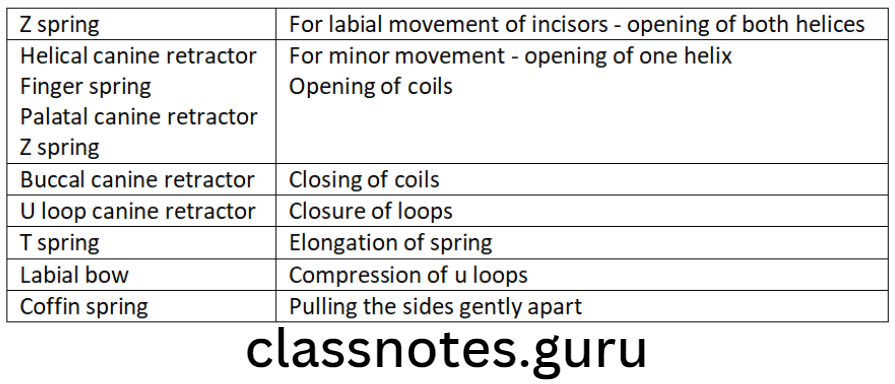
Types of labial bows
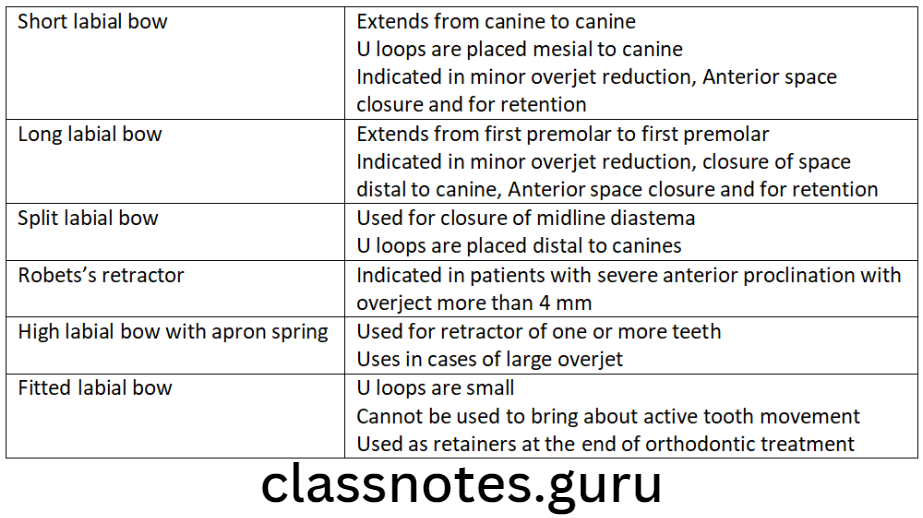
Types of springs
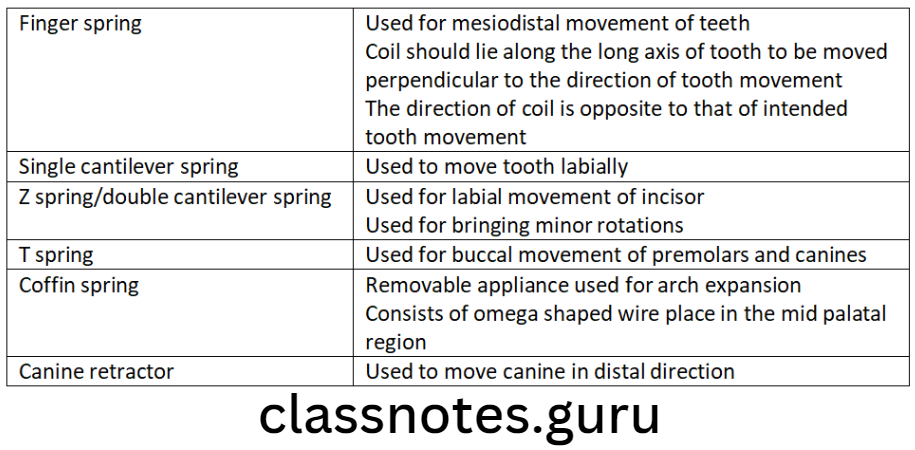
Removable Appliances Long Essays
Question 1. Classify orthodontic appliances and discuss in detail the various active components of removable appliances.
Answer.
Classification Of Orthodontic Appliances:
- Mechanical: Exerts mild pressure on the tooth
- Removable appliances
- Fixed appliances
Myofunctional: Harness natural muscular forces
- Removable appliance
- Fixed appliance
Active Components Of Removable Appliances:
Bows
- Used for incisor retraction
Types Of Bows:
- Short labial bow: Parts
- Bow
- ‘U’ loop
- Retentive arms distal to the canine
Uses: - Minor overjet reduction
- Anterior space closure
- For retention after fixed mechanotherapy
Read And Learn More: Orthodontics Short And Long Essay Question And Answers
Activation: Compressions of U loops
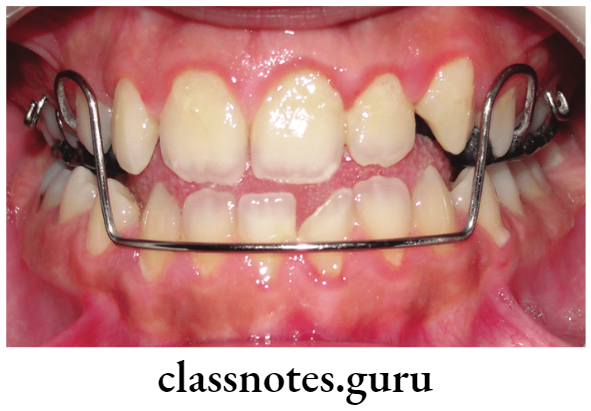
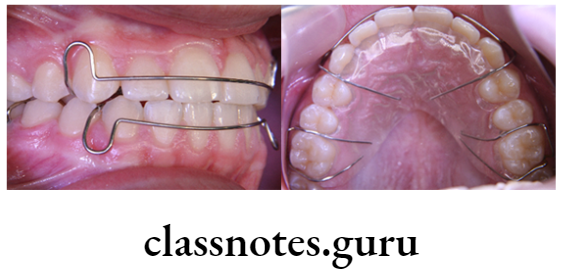
- Long labial bow: Extends from one 1st premolar to the opposite side
Indications:- Minor anterior space closure
- Overjet reduction
- Retaining device
- Closure of space distal to canine
- Split labial bow:
- Labial bow split in the middle
- Have separate buccal arms
Indications: - Midline diastema
- For anterior retraction
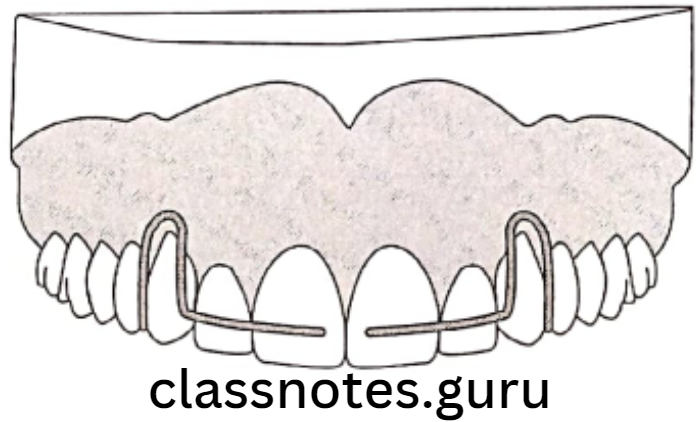
- Reverse labial bow: Free ends of U loops adapted occlusal
Activation:- Opening of U loop
- Compensatory bend at the base of U
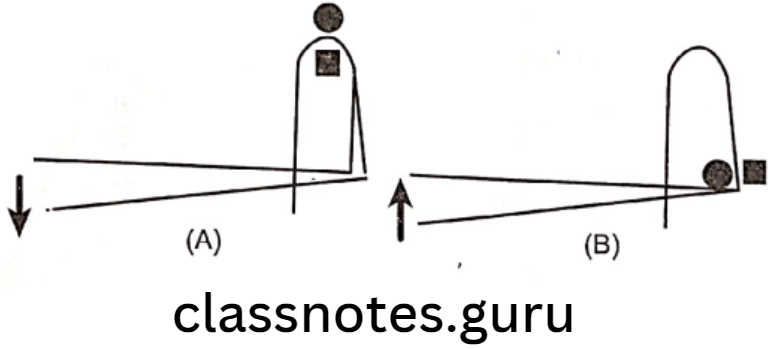
- Others:
- Robert’s retractor
- Mills retractor
- High labial bow with apron springs
- Fitted labial bow
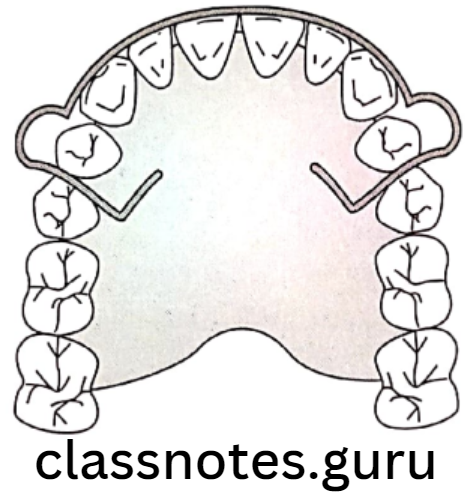
Springs
Classification:
- Based on the presence/absence of helix
- Simple without helix
- Compound with helix
- Based on the presence of loops/helix
- Helical springs
- Looped springs
- Based on the nature of the stability of spring
- Self-supported
- Supported
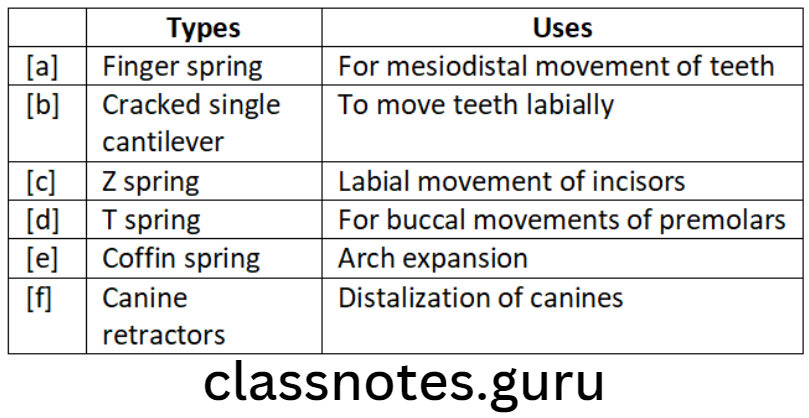
Screws:
- To bring about different tooth movement
Example:
- Arch expansion
- Buccal movement of teeth
- Mesial/distal movement of teeth



Elastics:
- For anterior retraction
- May cause gingival trauma

Removable Appliances Short Essays
Question 1. Adam’s clasp and its modifications.
Answer.
- By Professor Phillip Adams
Synonyms Of Adam’s Clasp:
- Liver pool clasp
- Universal clasp
- Modified arrow head clasp
Wire Used:
- 0.7 mm round stainless steel
Parts:
- Two arrowheads – Engaging proximal undercuts
- Bridge – Connects two arrowheads
Two Retentive Arms – Incorporated In Acrylic
Advantages Of Adam’s Clasp:
- Rigid retentive
- Simple to fabricate
- Occupies minimum space
- Can be used for
- Deciduous and permanent teeth
- Partially and fully erupted teeth
- Incisors, premolars and molars
- Modified in many ways

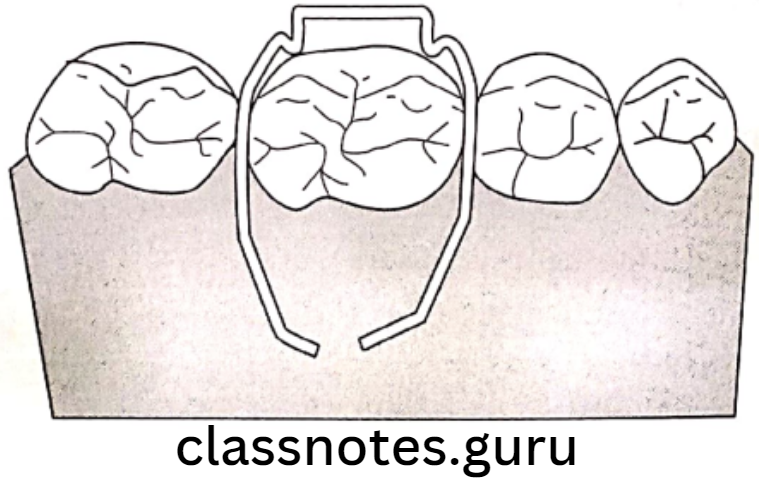
Modifications Of Adam’s Clasp:
- Adams with single arrowhead
- Adams with additional arrowhead
- Adams with J hook
- Adams with incorporated helix
- Adams with soldered buccal tube
- Adams with distal extraction
- Adams on incisors and premolars
Question 2. Canine retractors.
Answer.
U loop canine retractor:
- Wire used – 0.6/0.7 mm
Parts Of U loop canine retractor:
- U loop: Base is 2-3 mm below the cervical margin
- Active arm:
- Bent at right angles
- Passed below mesial contact point of canine
- Retentive arm: Incorporated in acrylic
Uses: In 1-2 mm of retraction
Helical canine retractor:
- Wire – 0.6mm
Parts Of Helical canine retractor:
- Coil – 3mm diameter
- Active arm – towards tissue
- Retentive arm
Activation: Opening of helix
Use: In shallow sulcus
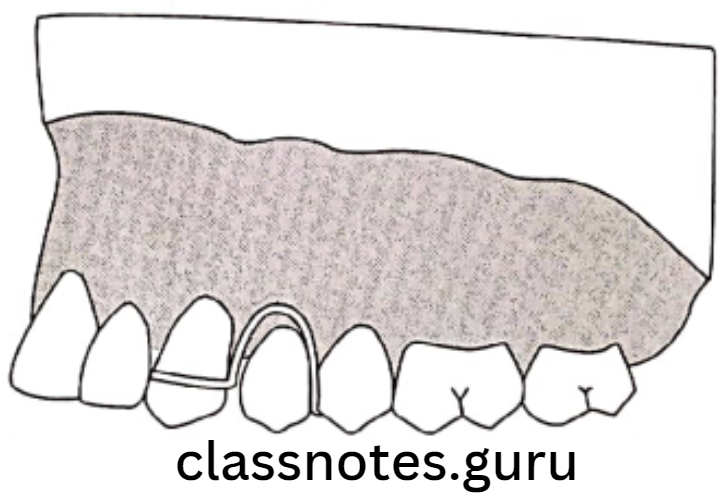

Palatal canine retractor:
- Wire – 0.6mm
Parts:
- Coil – 3mm diameter
- Active arm – mesial to canine
- Guide arm
Use: Retraction of palatally placed canine
Buccal canine retractor:
Uses Of Buccal Canine Retractor:
- Bucally placed canines
- Highly placed canines
Parts Of Buccal Canine Retractor:
- Coil – 3mm diameter
- Active arm – away from tissue
- Retentive arm
Types Of Buccal Canine Retractor:
- Supported – with 0.5mm wire
- Self-supported – with 0.7 mm wire
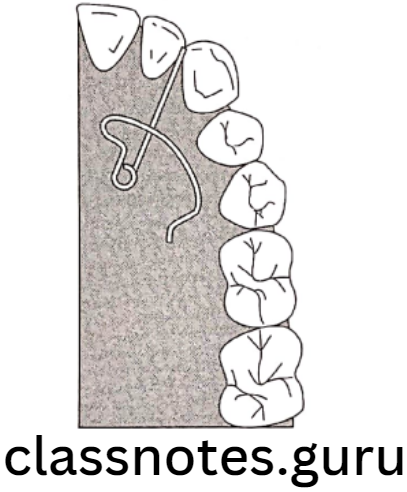
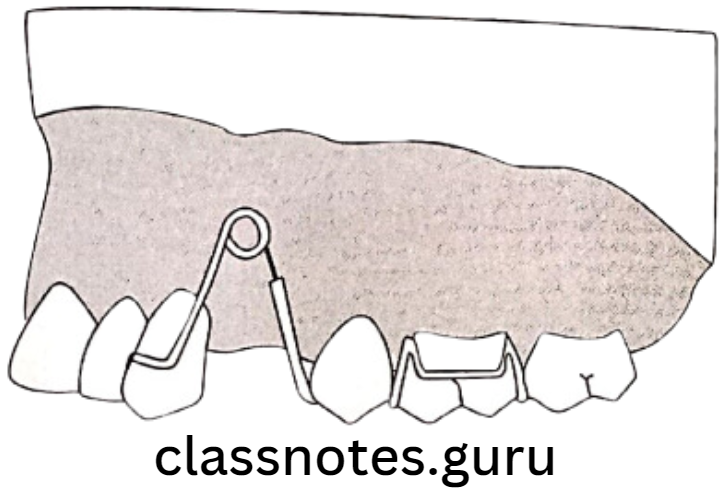
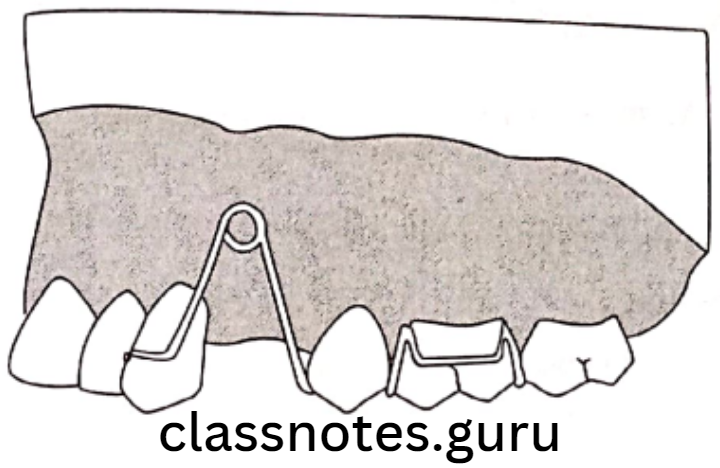
Question 3. Advantages and disadvantages of removable appliances.
Answer.
Advantages Of Removable Appliances:
- Oral hygiene maintenance
- Useful in tipping movement
- Less chair time
- Convenient for operators to handle more patient
- Fewer forces required
- Not technique sensitive
- Easy to fabricate
- Relatively cheaper
- Damaged appliances can be replaced
Disadvantages Of Removable Appliances:
- Poor patient cooperation
- Capable of only tipping movement
- Prolonged duration of treatment
- Difficult to treat multiple-movement
- Difficult to close residual space created due to extraction
- Risk of damaging and misplacing appliances by patient
- Cannot be used to treat severe cases of Class 2 and Class 3 malocclusions with the unfavorable growth pattern
Removable Appliances Short Questions And Answers
Question 1. Z spring/Double cantilever.
Answer.
Uses Of Z spring:
- Labial movement of incisors
- Minor rotation of incisors
Wire used: 0.5 mm
Parts Of Z spring:
- Two coils
- Retentive arm – 10-12 mm length
Activation Of Z spring:
- Opening of helix
- One helix for rotation
- Both helices for labial movement
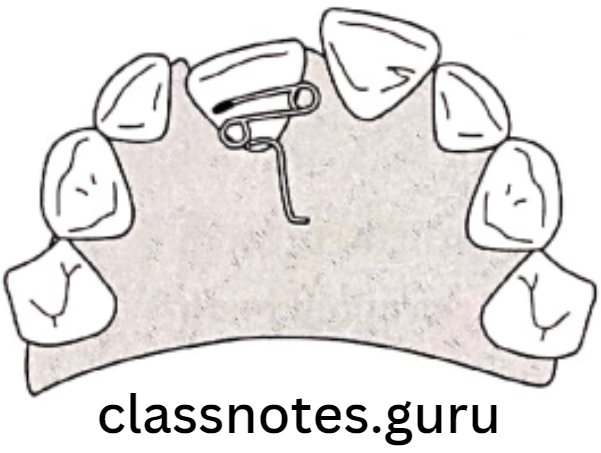
Question 2. Finger Springs/Single Cantilever.
Answer.
- One end is fixed and the other end is free
Wire used: 0.5/0.6mm
- Use
- Mesio distal movement of teeth
Parts Of Finger Springs:
- Active arm – 12-15mm length
- Helix – 3mm diameter
- Activation – Moving active arm towards teeth

Question 3. Cantilever Springs.
Answer.
Double cantilever:
Uses Of Double Cantilever:
- Labial movement of incisors
- Minor rotation of incisors
Wire used: 0.5mm
Parts Of Double Cantilever:
- Two coils
- Retentive arm – 10-12mm length
Finger Springs/Single Cantilever:
- One end is fixed and the other end is free
Wire Used: 0.5/0.6mm
Uses Of Finger Springs:
- Mesio distal movement of teeth
Parts Of Finger Springs:
- Active arm – 12-15mm length
- Helix – 3mm diameter
- Activation – Moving active arm towards teeth
Question 4. Canine Retractor.
Answer.
- Used for distalization of canines
Types Of Canine Retractors
U loop canine retractor:
- Wire used – 0.6/0.7mm
- Uses: In 1-2mm of retraction
Helical canine retractor:
- Wire – 0.6mm
- Use: In shallow sulcus
Palatal canine retractor:
- Wire – 0.6 mm
- Use: Retraction of palatally placed canine
Buccal canine retractor:
Uses Of Buccal Canine Retractor:
- Bucally placed canines
- Highly placed canines
Types Of Buccal Canine Retractor:
- Supported – with 0.5mm wire
- Self-supported – with 0.7 mm wire
Question 5. Adam’s clasp and its advantages
Answer.
- By Professor Phillip Adams
Synonyms Of Adam’s Clasp:
- Liver pool clasp
- Universal clasp
- Modified arrow head clasp
Wire Used:
- 0.7 mm round stainless steel
Parts Of Adam’s Clasp:
- Two arrowheads – Engaging proximal undercuts
- Bridge – Connects two arrowheads
Two Retentive Arms – Incorporated In Acrylic:
Advantages Of Adam’s Clasp:
- Rigid retentive
- Simple to fabricate
- Occupies minimum space
- Can be used for
- Deciduous and permanent teeth
- Partially and fully erupted teeth
- Incisors, premolars and molars
Removable Appliances Viva Voce
- T spring is activated by pulling the free end of the T
- Labial movement of incisors is achieved by Z spring
- Buccal movement of premolars and canines is achieved by T spring
- U loop canine retractor is activated by compressing the loop
- Finger spring is a single cantilever
- Z spring is also called a double cantilever
- A modified split labial bow is used for the closure of midline diastema
- The palatal canine retractor is activated by opening the helix by 2mm
- Adam’s clasp is most commonly used
- The reverse labial bow is activated by opening the U-loop
- The finger spring is activated by opening the helix
- Z spring is activated by opening both helices simultaneously
